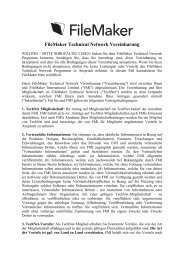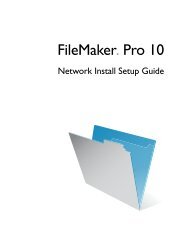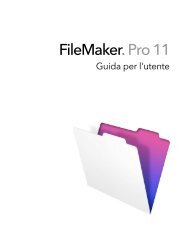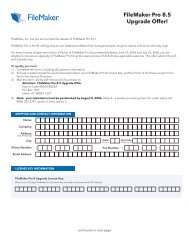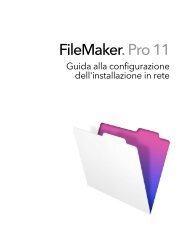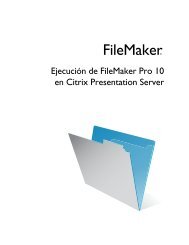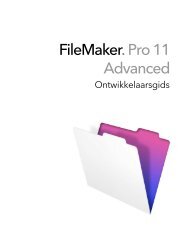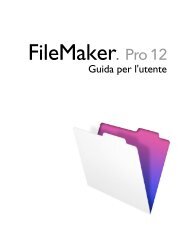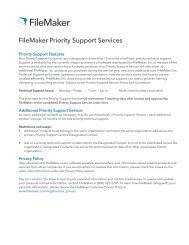Guida di FileMaker Server 12
Guida di FileMaker Server 12
Guida di FileMaker Server 12
You also want an ePaper? Increase the reach of your titles
YUMPU automatically turns print PDFs into web optimized ePapers that Google loves.
Glossario D, E<br />
D, E<br />
Client<br />
Un utente che stabilisce una connessione a un database ospitato su <strong>FileMaker</strong> <strong>Server</strong> con<br />
<strong>FileMaker</strong> Go, <strong>FileMaker</strong> Pro, un browser Web o un’applicazione client ODBC/JDBC. Un client<br />
<strong>FileMaker</strong> è un utente che utilizza <strong>FileMaker</strong> Go o <strong>FileMaker</strong> Pro. Un client <strong>di</strong> Pubblicazione Web<br />
è un utente che utilizza la Pubblicazione Web Imme<strong>di</strong>ata o la Pubblicazione Web Personalizzata.<br />
ClientStats.log<br />
Un file in cui vengono registrate informazioni statistiche sulle prestazioni <strong>di</strong> <strong>FileMaker</strong> <strong>Server</strong><br />
con ogni client <strong>di</strong> <strong>FileMaker</strong> e <strong>di</strong> Motore per la pubblicazione Web.<br />
Clone<br />
Una copia <strong>di</strong> un file <strong>di</strong> <strong>FileMaker</strong> Pro che contiene tutto i campi definizioni, tabelle, formati, script<br />
e le opzioni <strong>di</strong> configurazione pagina, ma nessuno dei dati.<br />
Collegamento fisico<br />
Una voce <strong>di</strong> <strong>di</strong>rectory che collega un nome a un file su un file system. Per migliorare le<br />
prestazioni <strong>di</strong> backup, se il server database rileva che un file ospitato è identico al file <strong>di</strong> backup<br />
più recente, il server database crea un collegamento fisico al file <strong>di</strong> backup più recente invece <strong>di</strong><br />
creare un’altra copia <strong>di</strong> backup del file.<br />
Compressione del file <strong>di</strong> database<br />
Il processo <strong>di</strong> rimozione <strong>di</strong> campi vuoti o <strong>di</strong> dati ridondanti o non necessari nei file <strong>di</strong> database<br />
per ridurre la quantità <strong>di</strong> spazio richiesta sul <strong>di</strong>sco.<br />
Copia <strong>di</strong> backup<br />
La copia <strong>di</strong> un file <strong>di</strong> database che può essere utilizzata al posto dell’originale se questo è<br />
andato perso, è danneggiato o è irrecuperabile.<br />
Data source name (DSN)<br />
Una struttura <strong>di</strong> dati che contiene le informazioni su un database specifico <strong>di</strong> cui un driver<br />
ODBC necessita per collegarsi ad esso.<br />
Database ospitato<br />
Un file aperto da <strong>FileMaker</strong> <strong>Server</strong> per consentire ai client <strong>di</strong> utilizzarlo in rete. Uno o più client<br />
contemporaneamente possono accedere ai database ospitati e mo<strong>di</strong>ficarne le informazioni.<br />
Distribuzione<br />
Il processo e il risultato dell’installazione e della configurazione <strong>di</strong> componenti <strong>FileMaker</strong> <strong>Server</strong><br />
su una o più macchine. In una <strong>di</strong>stribuzione su più macchine, i componenti vengono installati su<br />
più <strong>di</strong> una macchina e lavorano insieme come un’unità.<br />
Driver<br />
Il driver ODBC o JDBC traduce query SQL nei coman<strong>di</strong> che un DBMS può capire. Elabora le<br />
chiamate ODBC/JDBC, invia richieste SQL all’origine dati e restituisce i dati alla gestione driver,<br />
che a sua volta li in<strong>di</strong>rizza all’applicazione che ne ha fatto richiesta.<br />
Driver client JDBC<br />
Un file JAR (archivio Java) che invia una query SQL per accedere ai dati memorizzati in un<br />
database e consegna i dati richiesti all’applicazione client.<br />
Driver client ODBC<br />
Una DLL (Windows) o una libreria con<strong>di</strong>visa (Mac OS) che invia una query SQL per accedere ai<br />
dati memorizzati in un database e fornisce i dati richiesti all’applicazione client.<br />
GUIDA DI FILEMAKER SERVER <strong>12</strong> 199



